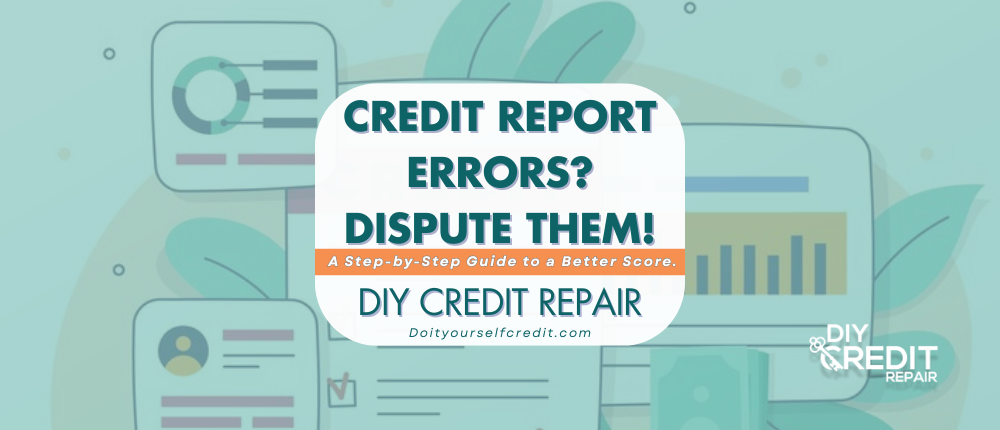
Your credit report is a vital part of your financial health, influencing everything from loan approvals to interest rates. Unfortunately, errors can creep in, potentially harming your credit score and financial opportunities. Fortunately, disputing these inaccuracies is a process you can navigate with confidence. In this guide, we’ll walk you through how to identify incorrect information on your credit report and the steps to file disputes effectively. Plus, we’ll introduce you to DIY Credit, a user-friendly platform that simplifies the entire process.
Before you begin the credit repair process, it’s crucial to address any existing issues with your current, active accounts. Make sure all your payments are up-to-date and that you’re not delinquent on any accounts. Catching up on late payments is essential before starting credit repair. Adding new negative information, such as late payments or new collections, during the repair process will damage your credit score and counteract any progress you make. Think of it like taking one step forward and two steps back – you want to create a solid foundation for improvement.
Step 1: Obtain Your Credit Reports
The first step in disputing errors is to obtain your credit reports from the three major credit bureaus: Equifax, Experian, and TransUnion. You’re entitled to one free report from each bureau every year, which you can request at AnnualCreditReport.com. However, we’ve partnered with SmartCredit to give you the power of continuous credit monitoring, ensuring you can track and review your credit status throughout the entire year. Once you have your reports, it’s time to review them carefully.
Step 2: Identify Incorrect Information
As you review your credit reports, look for common errors, including:
- Incorrect personal information: Ensure your name, address, and Social Security number are accurate.
- Accounts that don’t belong to you: Check for unfamiliar accounts that may indicate identity theft.
- Outdated negative information: Negative items should fall off your report after a certain period.
- Duplicate accounts: Make sure each account is listed only once.
- Incorrect account balances or payment statuses: Verify that all reported information is accurate.
Step 3: Document Your Findings
Once you’ve identified errors, document them thoroughly. Make copies of your credit reports, highlight the inaccuracies, and gather any supporting documentation, such as bank statements or payment records, that can help substantiate your claims.
Step 4: Prepare Your Dispute Letters
Next, you’ll need to prepare dispute letters for each error. Your letters should include:
- Your personal information (name, address, Social Security number)
- A clear description of the error
- Copies of supporting documentation
- A request for correction or removal of the inaccurate information
Step 5: Submit Your Disputes
Send your dispute letters to each credit bureau reporting the error. It’s best to use certified mail with a return receipt to ensure your disputes are received. Remember, the bureaus are required to investigate your claims within 30 days.
Step 6: Track Your Results
Monitoring the progress of your disputes is crucial. This is where DIY Credit can be a game-changer. By linking your credit report to DIY Credit, the platform automatically imports and analyzes your three-bureau credit reports, identifying negative accounts and preparing a tailored dispute strategy for you.
Why Choose DIY Credit?
- Automated Analysis: DIY Credit’s AI technology scans your credit reports for over twenty different types of errors, ensuring you don’t miss anything.
- Tailored Dispute Strategies: Different negative accounts require different approaches. DIY Credit helps you create the right dispute for each type of error, whether it’s a collection account or a bankruptcy.
- Ongoing Monitoring: DIY Credit tracks all your disputes across the three bureaus. You’ll receive monthly progress reports detailing which accounts were deleted and your updated credit scores, keeping you informed every step of the way.
Step 7: Stay Persistent
Disputing errors may take time, and it’s not uncommon for multiple rounds of dispute letters to be necessary. Stay the course and let DIY Credit guide you through the process until your credit repair is complete.
Conclusion
Disputing errors on your credit report is an essential step in maintaining your financial health. By following these steps and utilizing the resources available through DIY Credit, you can take control of your credit report and work towards a better credit score. Remember, accurate credit reporting is not just your right; it’s essential for your financial future.
For more personalized guidance, consider reaching out to credit experts who can provide real answers and strategies tailored to your situation. With the right tools and persistence, you can successfully dispute inaccuracies and improve your credit standing.